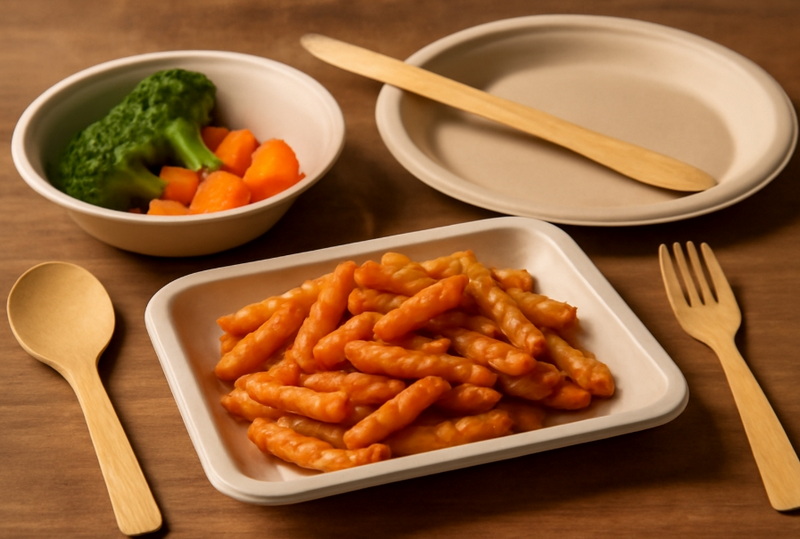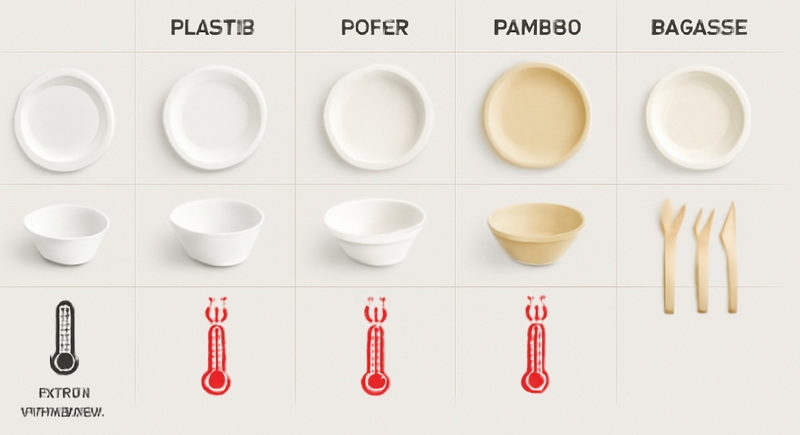
Content Menu
● Understanding Disposable Plates, Bowls, and Cutlery
>> Types of Disposable Tableware
● The Science: How Hot Foods Affect Disposable Tableware
>> Plastic Tableware and Heat
>> Paper Plates and Bowls with Hot Foods
>> Compostable and Biodegradable Tableware
● Health Risks: What Happens When Disposable Tableware Gets Hot?
>> Chemical Leaching
>> Microplastics
>> Physical Degradation
● Safety Tips for Using Disposable Plates, Bowls, and Cutlery with Hot Foods
● Environmental Impact: Beyond Personal Safety
>> Plastic Waste
>> Compostable Alternatives
● Choosing the Right Disposable Tableware for Hot Foods
>> Plastic
>> Paper
>> Compostable/Biodegradable
● Conclusion
● Frequently Asked Questions (FAQ)
>> 1. Are all disposable plates, bowls, and cutlery safe for hot foods?
>> 2. What materials are best for disposable cutlery when serving hot foods?
>> 3. Can I microwave food on disposable plates and bowls?
>> 4. Are compostable plates and cutlery safe for hot foods and liquids?
>> 5. What are the environmental benefits of choosing biodegradable disposable tableware?
Disposable plates, bowls, and cutlery have become essential in our fast-paced lifestyles. Whether it's for a family picnic, a birthday party, office lunch, or takeout from your favorite restaurant, these single-use items offer unmatched convenience. However, as their use becomes more widespread, concerns about their safety—especially when serving hot foods—are increasingly relevant. This comprehensive article explores the safety of disposable plates, bowls, and cutlery for hot foods, delving into material science, health implications, environmental impact, and best practices for safe use.

Understanding Disposable Plates, Bowls, and Cutlery
Disposable tableware comes in many forms, each with its own characteristics and safety considerations. Understanding the materials is the first step in determining their suitability for hot foods.
Types of Disposable Tableware
- Plastic Plates, Bowls, and Cutlery: These are commonly made from polystyrene, polypropylene, or other types of plastic. Their properties vary depending on the type of plastic used.
- Paper Plates and Bowls: Often lightweight and cost-effective, these may be coated with a thin layer of plastic or wax to improve durability and moisture resistance.
- Compostable or Biodegradable Options: Made from materials such as cornstarch (PLA), bagasse (sugarcane fiber), bamboo, or wood, these are marketed as environmentally friendly alternatives.
Each material interacts differently with hot foods, affecting both safety and environmental impact.
The Science: How Hot Foods Affect Disposable Tableware
Plastic Tableware and Heat
Plastic disposable plates, bowls, and cutlery are highly convenient but their safety with hot foods depends on the type of plastic and its heat resistance. When exposed to high temperatures, some plastics may:
- Warp or Melt: Standard plastics can deform when in contact with hot foods or liquids.
- Leach Chemicals: Heat can cause plastics to release chemicals such as BPA, phthalates, or styrene into food, especially if the plastic is not designed for high temperatures.
Heat-resistant plastics, such as certain grades of polypropylene, are designed to withstand higher temperatures and are generally safer for hot foods. Always check if the product is labeled as heat-resistant or microwave-safe before use.
Paper Plates and Bowls with Hot Foods
Paper plates and bowls are popular for their lightweight feel and disposability. Their safety with hot foods depends on several factors:
- Uncoated Paper Plates: These can quickly become soggy or fall apart when used with hot or moist foods. They are best suited for cold or dry foods.
- Coated Paper Plates: Many have a thin plastic or wax lining to prevent leaks, but this coating can sometimes leach chemicals into food when exposed to high temperatures, especially with greasy or acidic foods.
- Microwave-Safe Paper Plates: Some paper plates are specifically designed for use with hot foods and reheating. Always look for microwave-safe labeling and avoid overheating.
Compostable and Biodegradable Tableware
Eco-friendly options like PLA (polylactic acid), bagasse, or bamboo are becoming more popular:
- PLA Cutlery and Plates: PLA is compostable and suitable for cold foods, but it can warp or degrade with high heat, making it less ideal for very hot foods.
- Bagasse and Bamboo: These materials are generally heat-resistant and safe for hot foods, offering a sturdy and sustainable alternative to plastic and traditional paper.
Health Risks: What Happens When Disposable Tableware Gets Hot?
Chemical Leaching
When disposable plates, bowls, and cutlery are exposed to heat, there is a risk that chemicals used in their manufacture can migrate into food. This risk is highest with:
- Non-heat-resistant plastics: These may release chemicals such as BPA, phthalates, or styrene, which are linked to various health concerns.
- Coated paper products: Some coatings contain substances that can migrate into food when heated, especially with greasy or acidic foods.
Microplastics
Heating plastic tableware can cause it to break down into microplastics, tiny particles that may end up in your food and, eventually, your body. Microplastics have been linked to immune system problems and other health concerns.
Physical Degradation
Hot foods can cause some disposable plates and cutlery to warp, melt, or break, leading to spills or the potential ingestion of small fragments.
Safety Tips for Using Disposable Plates, Bowls, and Cutlery with Hot Foods
- Check Labels: Only use products labeled as heat-resistant or microwave-safe for hot foods.
- Avoid Extreme Heat: Do not use standard disposable plastic or paper products in ovens or for boiling-hot foods.
- Limit Use with Greasy or Acidic Foods: These can increase the risk of chemical leaching from coated paper products.
- Choose Safer Materials: For hot foods, opt for heat-resistant plastics, sturdy paper plates labeled for hot use, or natural materials like bamboo or bagasse.
- Single Use Only: Do not reuse disposable tableware, especially after exposure to heat, as repeated use increases the risk of chemical leaching and bacterial growth.
- Proper Storage: Keep disposable tableware in a cool, dry place to prevent contamination and degradation.

Environmental Impact: Beyond Personal Safety
Disposable plates, bowls, and cutlery are not just a health concern—they also pose significant environmental challenges.
Plastic Waste
Traditional plastic tableware can take hundreds of years to decompose, contributing to landfill overflow and pollution. During this time, plastics can break down into microplastics, contaminating soil and water and entering the food chain.
Compostable Alternatives
Biodegradable and compostable options, such as those made from bagasse or bamboo, break down much faster and are less likely to release harmful chemicals. However, they require proper composting facilities to realize their environmental benefits.
Choosing the Right Disposable Tableware for Hot Foods
Plastic
- Best for: Cold foods, unless specifically labeled as heat-resistant.
- Risks: Chemical leaching, microplastics, environmental harm.
- Safer Alternatives: Heat-resistant plastics (polypropylene), BPA-free options.
Paper
- Best for: Cold or mildly warm foods.
- Risks: Sogginess, chemical leaching from coatings, not always microwave-safe.
- Safer Alternatives: Microwave-safe, uncoated paper plates for short-term use.
Compostable/Biodegradable
- Best for: Hot foods if made from bagasse, bamboo, or heat-resistant certified materials.
- Risks: Some compostable plastics (PLA) may warp with very hot foods.
- Safer Alternatives: Certified compostable products with heat-resistance labeling.
Conclusion
Disposable plates, bowls, and cutlery offer undeniable convenience, but their safety with hot foods depends on the materials used and how they are manufactured. Standard plastics and coated paper plates can leach harmful chemicals when exposed to heat, while eco-friendly alternatives like bagasse and bamboo are generally safer for hot foods. Always check for heat-resistance labeling, avoid exposing disposables to extreme temperatures, and consider the environmental impact of your choices. By making informed decisions, you can enjoy the convenience of disposables without compromising your health or the planet.

Frequently Asked Questions (FAQ)
1. Are all disposable plates, bowls, and cutlery safe for hot foods?
Not all disposable tableware is safe for hot foods. Only products labeled as heat-resistant or microwave-safe should be used for hot dishes. Standard plastics and some coated paper plates may release harmful chemicals when exposed to high temperatures.
2. What materials are best for disposable cutlery when serving hot foods?
Heat-resistant plastics (like certain polypropylene), wooden cutlery, and certified compostable materials made from bagasse or bamboo are best for hot foods. Avoid standard plastic or PLA cutlery for very hot dishes, as they may warp or leach chemicals.
3. Can I microwave food on disposable plates and bowls?
Only microwave-safe disposable plates and bowls should be used for reheating food. Many paper and plastic disposables are not designed for microwave use and may release chemicals or become damaged. Always check the packaging for microwave-safe labeling.
4. Are compostable plates and cutlery safe for hot foods and liquids?
Most compostable plates and cutlery are safe for hot foods and liquids, but their heat resistance varies by product. Look for certifications and heat-resistance labels to ensure safety. PLA-based products are better for cold foods, while bagasse and bamboo are more heat-resistant.
5. What are the environmental benefits of choosing biodegradable disposable tableware?
Biodegradable and compostable tableware breaks down faster than traditional plastics, reducing landfill waste and environmental pollution. Materials like bagasse and bamboo are renewable and do not release harmful chemicals during decomposition, making them a more sustainable choice.

















